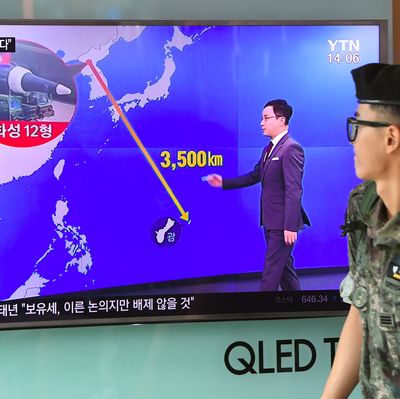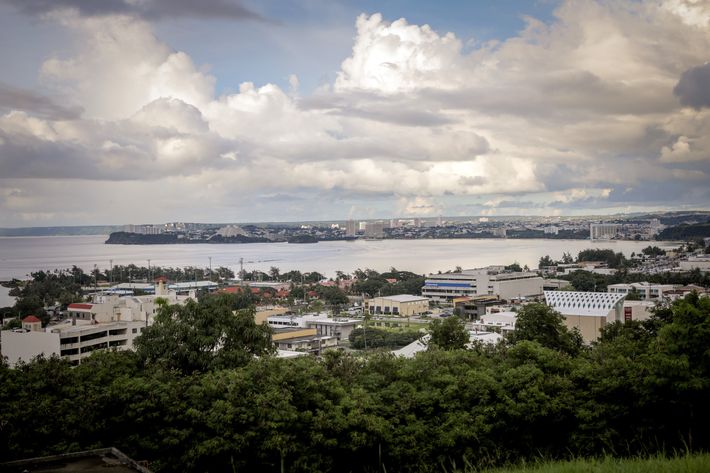
In response to President Donald Trump’s trash-talking pledge on Tuesday to meet any threat from North Korea with “fire and fury like the world has never seen,” dictator Kim Jong-un promptly called his bluff by threatening to fire a volley of ballistic missiles in the general direction of Guam. In turn, Trump dialed up his own rhetoric even further, opining in a press conference on Thursday that perhaps his unplanned “fire and fury” statement, which many interpreted as a threat of nuclear war, had not been “tough enough.”
Amid this war of words that threatens to turn into a war of a more literal variety, it’s worth taking a moment to understand just what North Korea is up to here. Is Kim’s threat genuine, or is he blowing smoke? If it is real, how concerned should we be? And why is Guam his target?
First of all, let’s be clear that North Korea is not threatening to nuke Guam. What the regime has said it is doing is preparing a plan (which it now claims will be ready within days) to launch a series of Hwasong-12 intermediate-range ballistic missiles over Japanese territory and into the sea 30 to 40 kilometers off the coast of Guam (just outside its territorial waters but well within its exclusive economic zone) in an “enveloping fire.” Such a launch would not do any damage to U.S. citizens or military assets, but would demonstrate that the island is within range of the Hwasong-12, which Pyongyang claims is capable of delivering a nuclear payload. That might well cause panic among the U.S. public — a psychological warfare win for North Korea.
The Defense Intelligence Agency concluded in a recent report that Pyongyang has succeeded at producing a miniaturized nuclear warhead that can fit inside its missiles, so Kim’s threat to menace U.S. territory with nuclear-capable missiles is now considerably more credible than it was even six months ago. However, it is not clear that the Hwasong-12 can actually reach Guam, which is 3,400 kilometers away from North Korea, near the outer limits of the missile’s estimated range. Weapons experts also doubt whether the Hwasong-12 can reliably deliver a nuclear device, so even if North Korea manages to launch its missiles within a few leagues of Guam, that doesn’t necessarily mean it can hit the island with a nuclear missile.

Nor is it clear that the North Koreans would actually want to wipe Guam off the map, even if they could. The island, which the U.S. snatched from Spain in 1898 and has used as a strategic outpost in the Pacific ever since, is home to an airfield, a naval station, and 160,000 Americans, of whom 7,000 are military personnel. It’s a home port for our nuclear submarines and the launch point for the nuclear-capable strategic bombers we periodically send on flyovers of the Korean Peninsula (as we did in July). For any country that wanted to cripple American conventional and nuclear power in the Pacific theater, Guam would be a prime target.
But surely Kim knows that an actual attack on Guam, nuclear or otherwise, would be met with an overwhelming U.S. response that would surely mean the end of his reign and his life (along with those of perhaps hundreds of thousands of other North and South Koreans). Most experts believe that Pyongyang’s quest for nuclear weapons is not geared toward launching a suicidal first strike, but rather a check against any attempt by the U.S. to finish the job we failed to do in the Korean War. Most likely, Kim does not want to start a nuclear war with the U.S. so much as he wants us to know he could strike back if we did so, or nuclearize a conventional conflict. So the threat to Guam remains theoretical.
In fact, there are reasons to believe this whole “enveloping fire” plan is a bluff by Pyongyang. According to CNN, South Korea’s military has detected no preparations for a missile launch from the north, and experts suspect the real purpose of the threat is geopolitical theater. Nor is this Guam’s first nuclear-diplomacy rodeo: Threatening to attack the island (or in this case, threatening to threaten it) is a well-worn step in the dance of bluster and propaganda the U.S. and North Korea have been doing for decades.
This latest warning is also bizarrely specific, including such details as the number of missiles Pyongyang plans to launch, precisely how far from Guam they expect them to land, and when the plan will be ready — but not when, or even whether, it will be carried out. If Kim does send missiles toward Guam later this month and they fall short of their targets, get shot down by our THAAD missile defense system, or fail to launch altogether, the whole exercise will be a humiliation rather than a triumph for the regime.
In addition, while last month’s DIA assessment suggested that North Korea is alarmingly further along in its weapons program than previously thought, we don’t know for sure how accurate that intelligence really is. As former NSA analyst John Schindler told PRI, it’s much more difficult to gather accurate intel on a country with which we have no diplomatic or trade relations, and what’s more, the North Koreans know we’re spying on them and do what they can to deceive us. They may have managed to miniaturize a nuclear warhead, but they would also love for us to think they have even if they’ve yet to do so — just as they would love for us to think they are planning to fire missiles at Guam next week.





























